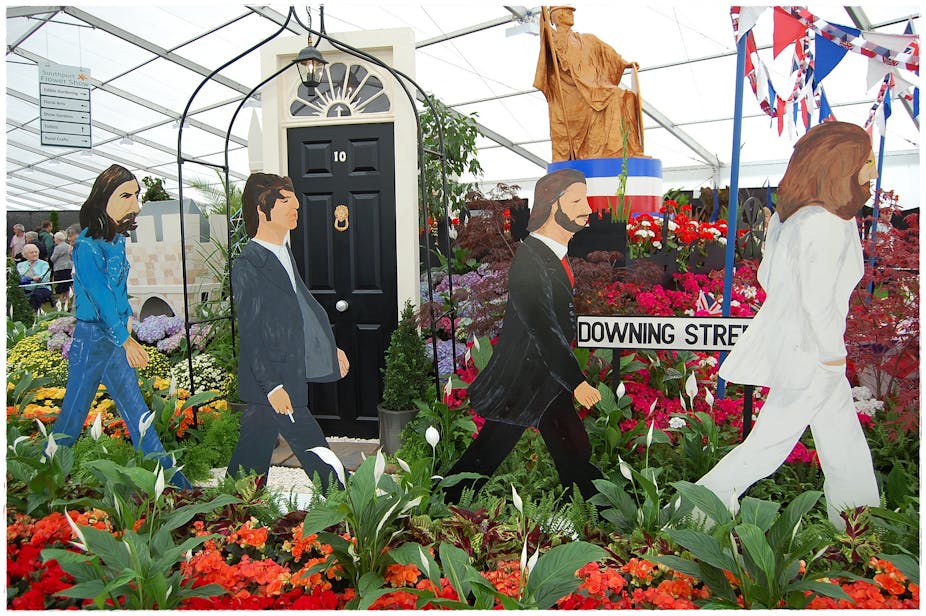In the gardens of No 10 Downing Street today, UK-time, Prime Minister David Cameron will host a reception to celebrate “the best of Britain’s creative industries”. Tory celebrities such as Sir Michael Caine and Simon Cowell appear on the guest list, together with less-than-A-list musos such as Eliza Doolittle and luvvies such as Dame Helen Mirren, Emma Watson and Benedict Cumberbatch.
The fact that Cumberbatch described Cameron as “fat-faced and flatulent” indicates that the party organiser, Gabby Bertin, might have struggled to get the notoriously Labour-leaning Brit celebs to attend the party. What political message is Cameron trying to communicate?
As a number of commentators have observed, the event looks like a cover version of Tony Blair’s New Labour reception held in July 1997, which featured an era-defining shot of Oasis singer Noel Gallagher shaking hands with Tony Blair while Young British Artist (YBA) Damien Hirst looked on admiringly. Later Gallagher admitted to snorting coke in the Downing Street loo.
Cameron, of course, is well known for his fixation with Tony Blair and the manner in which he rebranded the British Labour party in the 1990s, led it to a landslide victory in the general election of May 1997 and launched a fateful programme of constitutional, educational, health care, and criminal justice reform.
Cameron aspires to do something similar for the British Conservative party, rendering it, if nothing else, “nicer”. Consequently, it’s not surprising that the gig in the gardens has been dubbed “Cool Britannia 2”.
What, we might wonder, was Cool Britannia mark one? And what did it represent politically?
The original Cool Britannia
Cool Britannia in fact predated the arrival of the New Labour government in May 1997, but Tony Blair and his media guru Alistair Campbell were quick to latch onto the evolving Brit pop scene of the mid 90s to give the reinvented party a hip cachet that distinguished it both from Old Labour’s sterile class war rhetoric and the mixture of sleaze and stuffiness that characterised the last days of John Major’s Conservative government.

Newsweek journalist Stryker McGuire had first noticed the new optimism that gripped London in the wake of Thatcher’s mid-80s Big Bang that reinvented the City as a global financial hub.
After the trauma of the 80s, new Brit art characterised by the fashionably acclaimed work of Damien Hirst, and Tracey Emin, Brit fashion with its sought after designers Alexander McQueen and John Galliano and most of all Brit pop in the shape of Suede, Blur and Oasis represented a new and egalitarian cultural scene at ease with a post-imperial multiculturalism.
An impressed Mcgire deemed London “the coolest city on the planet”. Subsequently, in March 1997, Vanity Fair declared Britannia Cool with a front cover depicting Patsy Kensit and Noel’s brother, Liam, as the faces of a “London that swings again”.
Blair and his spin team harnessed this multicultural, post-imperial and egalitarian hipness to a New Labour agenda that embraced the globalised market but sought also to modernise the UK image to fit a post Cold War order in a world without borders.
Blair’s favourite academic, London School of Economics’ Professor Lord Anthony Giddens identified in The Third Way: The Renewal of Social Democracy (1998) the dilemmas the end of the Cold War posed, notably: the death of traditional socialism; the social divisiveness of “market fundamentalism”; the problem of inclusivity and social justice; and the challenges of globalisation.

According to Giddens, Blair’s renewal of UK Inc would:
help citizens pilot their way through the major revolutions of our time globalisation, transformation in social life and our relationship to nature.
If Cool Britannia, with Spice Girl Gerri Halliwell dressed in an iconic Union Jack mini dress, represented the culture of the third way, Blair’s programme of modernisation constituted its political agenda.
As Blair told it, in his Labour Party Conference speech of 1994: “modernisation is not the enemy of justice, but its ally”. It involved a “complex journey” towards a renewed sense of “Britishness”.
More precisely, it demanded constitutional reform on an unprecedented scale. By the end of 1997, the government had held referenda in Scotland, Wales, Northern Ireland and London. As a result, Wales and Northern Ireland found themselves with new assemblies, Scotland with a parliament and London an elected mayor.
Somewhat curiously, Blair considered this exercise in devolution and the abdication of parliamentary sovereignty would somehow unite the kingdom. In his Britain Speech (2000), he argued that:
the constitutional changes we have made, and a new attitude to engagement with Europe, are not a threat to British identity but the means of strengthening it for today’s world.
More than anything else, Richard Rogers’ Millennium Dome symbolised Cool Britannia and the “values” Blair thought made it great. The fibreglass carbuncle on the face of South London opened with a self-referential festival in January 2000. It announced “who we are” and “what we do”. Blair called it, “a triumph of boldness over blandness, of confidence over cynicism, and excellence over mediocrity”.

This progressive narrative, moreover, served an ideological purpose. Blair’s image-makers presented him as above politics, and the third way as a depoliticised project in techno managerialism that “synergised dynamic markets” with “strong communities”.
New Labour functioned not as a party but a form of corporate populism. Its close ties with celebrities, the BBC and the Murdoch press turned the party into a vast media corporation, politics into theatre and voters into increasingly detached spectators.
Hope and posturing rapidly gave way to voter alienation and disillusionment.
Nothing exemplifies this failure of the political class and its irrelevance to the demos than Cameron’s deluded endeavour to reboot Cool Britannia 2.0.
The Blair-lite attempt “to woo new voters” through celebrity by association merely gives official approval to narcissism on steroids. In an era when Brits appear anxious rather than cool, such posturing only further alienates the rulers from the ruled and reduces politics to a spectator sport – three cheers for uncool Britannic democracy.

